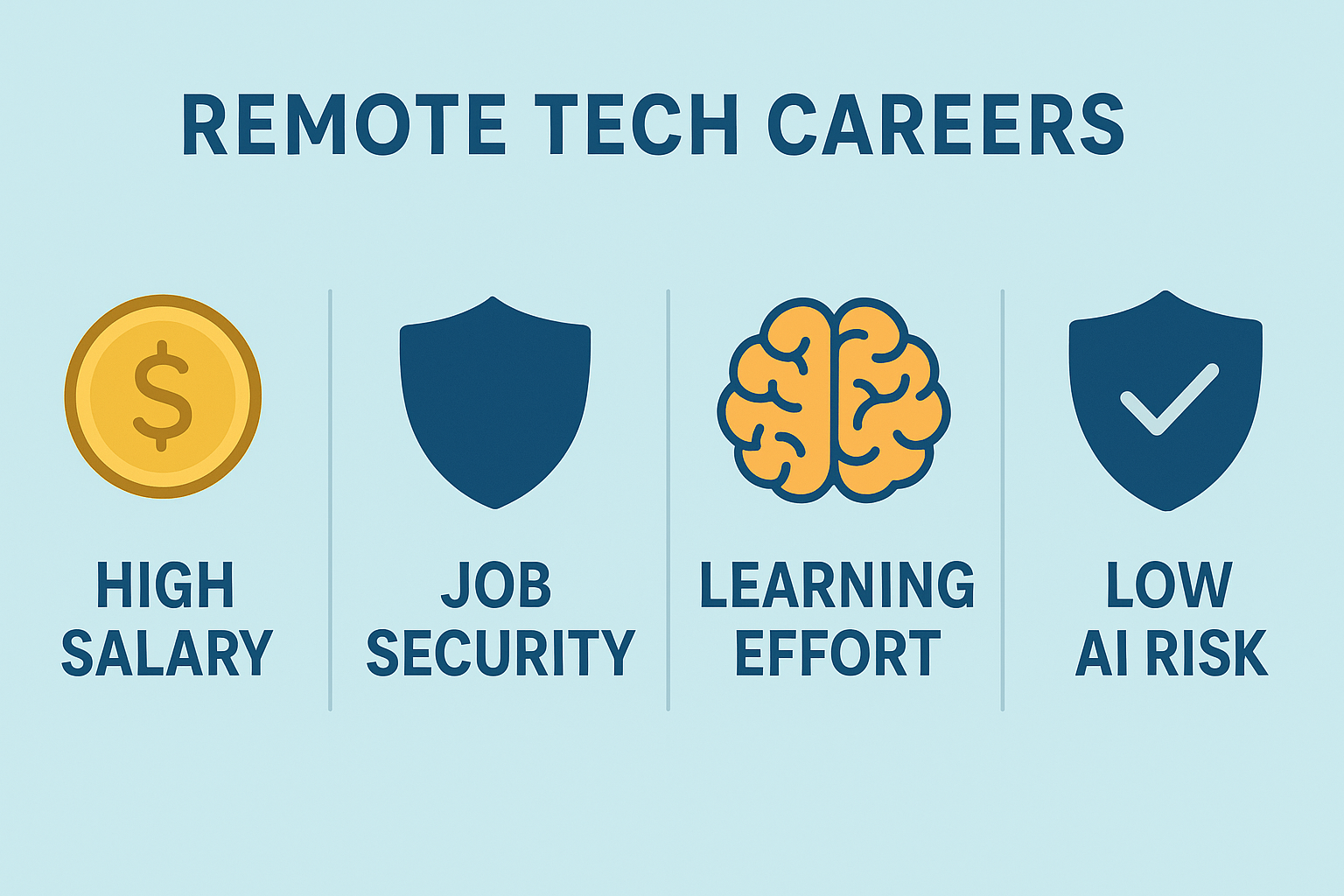Find the Remote Path That Fits You
What if you could build a life where Mondays are as exciting as Fridays, because you’re free to work from anywhere? This guide will help you do exactly that. We’re here to help you navigate the world of remote jobs and online businesses so you can find an option that matches your skills, interests, and the lifestyle you dream about. Remote work has never been more popular or accessible – the opportunities are vast, whether you have a college degree or not. In fact, many high-paying remote jobs don’t require a four-year degree at all, focusing more on skills and experience.
Who is this guide for?
In short, anyone who wants the freedom of remote work! People from all walks of life are transitioning to remote careers and businesses. You might see yourself in one of these groups:
Career Switchers: Thinking of learning new skills (like coding) to land a high-paying tech job after years in a different field.
Non-Tech Professionals: Not a “techie”? Perhaps you have experience in marketing, education, writing, customer service, etc. Good news – many roles in these fields can now be done from home or anywhere.
Adventurous Travelers & Nomads: Dream of working while traveling the world – maybe teaching English online, doing freelance gigs as you explore, or finding remote gigs that let you live abroad.
Parents & Caregivers: Need better work-life balance and flexibility. Remote work lets you be home for family or other responsibilities while still building your career.
Students & New Grads: Starting your career and thinking, why not start remotely? There are entry-level remote jobs that let you skip the commute and office politics from day one.
No matter which category (or combination) you fit into – even if you don’t fit neatly into any – this guide will help you identify the best remote career path for your goals and background, and show you how to get started.
Take the Interactive Remote Career Planner Quiz
Not sure where to begin? Start with our fun Interactive Remote Career Planner Quiz. This quick quiz (13 questions) will narrow down 100+ remote career options to a few that suit you best. It asks about your skills, interests, willingness to retrain, salary goals, and more – then gives you personalized suggestions. It’s like a matchmaking tool for your remote career! You’ll get a custom list of remote job or business ideas tailored to you, plus training resources for each option.
Take the Remote Career Quiz – see which path fits you and get your personalized remote career plan.
(Quiz not your thing? No worries – read on for an overview of top remote careers and how to choose yours!)
Hot air balloons launch at sunrise in Cappadocia, Türkiye
Remote Tech Careers: High-Paying Paths in Tech
If a high-paying remote job is your goal, the tech industry is one of the best avenues. Roles like software developer, data analyst, UX/UI designer, cybersecurity specialist, etc., are in huge demand and can often be done 100% remotely. Many of these positions come with salaries well above the national average. For example, remote software engineers commonly earn over $80,000 per year (entry-level around $70k, and experienced developers can clear six figures). In fact, several of the highest-paying remote jobs are tech roles (think software engineering, data science, cloud computing). As a bonus, these skills are sought-after worldwide, giving you job security and global opportunities.
💰 Pay Range: Typically mid to high. Many tech roles pay around $70k–$150k+ per year. (Entry-level developers often start ~$70–80k; senior engineers can earn $100k+.)
📈 Demand & Stability: High. There’s consistent demand for tech skills, and companies across the globe actively hire remotely for these roles. Tech expertise = strong job security.
🎓 Ease of Starting: Medium. You don’t necessarily need a college degree to break in, but you do need specialized training and lots of practice. Expect to invest a few months to a year in learning the skills for an entry-level role. (The upside: tech skills can be learned online from anywhere!)
🤖 AI Risk: Low. While AI can assist with coding or data analysis, it can’t replace human developers and problem-solvers. Tech roles involve creativity and complex thinking that aren’t easily automated – if anything, AI is a tool that developers use, not a replacement.
✅ How to Begin: Build in-demand skills like web development, data analysis, or UX design through focused study and hands-on projects. You have two main training routes to choose from:
Fast-Track Bootcamp: Consider enrolling in a coding bootcamp for a comprehensive, job-focused learning experience. (We offer a highly affordable Remote Coding Bootcamp designed to take beginners from zero to job-ready in under a year – it’s self-paced and online. You’ll build real projects, earn industry-recognized certifications, and even get career support. We’ve priced it at just $249 because we believe anyone willing to put in the effort should have a shot at a tech career.) A structured program like this is ideal if you want guidance, a clear curriculum, and quicker results.
DIY Self-Study: If you prefer a self-paced, lower-cost approach, check out our Remote Coding Roadmap eBook. It outlines exactly what to learn (and in what order) to land a junior tech role without a degree. The roadmap points you to free/cheap online courses, practice projects, and interview prep resources – essentially, it’s the path we wish we had when starting out!
With tech skills under your belt, you can pursue titles like Web Developer, Software Engineer, Data Analyst, Data Scientist, QA Tester, and more. Many entry-level remote tech jobs don’t require a CS degree – employers care more about what you can do (your portfolio, projects, and certifications) than a diploma. Plus, tech expertise gives you flexibility to either freelance (take on coding projects for clients via platforms like Upwork) or land a full-time remote job with a company. For instance, you might start by doing freelance web projects to build experience and income on your own schedule, or aim for a full-time developer role at a remote-friendly company for steady salary and benefits. It’s up to you – tech skills open doors to both paths.
Lifestyle: Remote tech jobs tend to offer some of the highest salaries in the remote work world. An entry-level developer working remotely might start around $65k–$80k/year, and within a few years could be making well into six figures. These jobs are usually full-time (40 hrs/week) but often come with flexibility in when you work, as long as you meet deadlines. Some companies still keep a 9–5 schedule (especially for team collaboration), but many are results-oriented and let you arrange your own hours. Bottom line: If you enjoy solving problems and creating with technology, a remote tech career can be incredibly rewarding – and you can do it from anywhere with internet.
Examples of High-Paying Remote Tech Jobs
To inspire you, here are a few of the highest-paying remote-friendly tech roles (and what they do):
Machine Learning Engineer – Builds algorithms and AI models (think of the brains behind recommendation engines or AI applications). Average Salary: ~$85,000 - $260,000+ (experience and company size make a big range)
Data Scientist – Analyzes complex datasets to extract insights for business decisions. Requires stats and programming knowledge. Average Salary: ~$80,000 - $220,000+
DevOps Engineer – Focuses on automating and streamlining software development and IT operations (CI/CD pipelines, cloud infrastructure). Average Salary: ~$80,000 - $200,000+
Cloud Architect – Designs and manages cloud computing systems for organizations. Often requires deep knowledge of platforms like AWS or Azure. Average Salary: ~$120,000 - $220,000+
Blockchain Developer – Develops applications using blockchain tech (for cryptocurrencies, smart contracts, etc.). Average Salary: ~$80,000 - $200,000+
Software Developer (Web/Mobile) – Creates software applications for web or mobile. (This is a broad category; specific technologies or industries can affect pay.) Average Salary: ~$70,000 - $120,000+
Information Security Analyst – Protects computer systems and networks from breaches and cyberattacks. Average Salary: ~$75,000 - $125,000+
Cybersecurity Engineer – Designs and implements security measures to safeguard systems. Average Salary: ~$85,000 - $130,000+
(These are ballpark figures; salaries vary by region and company. For instance, a US-based developer might earn more than one based elsewhere, but the cost of living differs. The beauty of remote work is you might earn a U.S. salary while living somewhere with a lower cost – a concept called geoarbitrage we’ll touch on later!)
Resources to get started: In addition to our own bootcamp and roadmap, there are many online platforms where you can begin learning tech skills. For example, freeCodeCamp, Codecademy, Coursera, and Udemy offer beginner-friendly coding courses (some free, some low-cost). The key is consistent practice and building a portfolio of small projects to show off your abilities. We also have an in-depth article on High-Paying Remote Tech Careers (covering what each role entails and which skills or certs you’d need) – check that out if you want to explore specific tech roles further.
Pro Tip: Don’t be intimidated if you don’t consider yourself “techy” right now. With the right roadmap and support, people from all kinds of backgrounds – teachers, artists, even truck drivers – have learned to code and switched into remote tech jobs. If you’re willing to invest a few months in learning, this path can transform your earning potential and freedom.
Remote Careers in Non-Tech Fields
Tech isn’t the only way to work remotely. Maybe coding just isn’t your thing – that’s okay! There are plenty of non-tech remote jobs out there too. In today’s world, almost any job that’s primarily done on a computer can potentially be done from home (or anywhere). Let’s look at some popular non-technical remote career categories, and how to get started in each one.
(Fun fact: You’ve probably heard of people who travel the world as “digital nomads” making money through blogging, YouTube, or Instagram - like Nomadic Matt, Drew Binsky, or Nas Daily - but they didn’t start earning big money overnight. Many of them earn income via digital marketing, affiliate links, online courses, virtual assistant work, or other online hustles. It’s definitely possible to earn a living that way if you monetize smartly – but it usually takes time and effort to build up. So we often recommend starting with more straightforward remote jobs to pay the bills, and you can always grow an influencer or content biz on the side.)
Below are some common non-tech remote career paths, what you can expect in terms of pay and ease of entry, and tips on how to get started:
1. Digital Marketing & Social Media
Do you have a knack for communication, social media, or strategy? Digital marketing could be a great remote career for you. Companies frequently hire remote roles like social media managers, SEO specialists, content marketers, email marketing coordinators, and more. If you’re creative or analytical (or both!), marketing lets you exercise those muscles and directly impact a business’s growth from anywhere.
Pay Range: Varies widely. Entry-level digital marketing assistants might start around $40k/year. Experienced marketing managers or strategists can earn $60k–$100k+. High-level consultants or marketing directors might exceed $120k, especially if they can drive big results. (It’s a field where results and experience often matter more than having a specific degree.)
Demand: Medium-High. Nearly every company needs marketing! There’s steady demand across industries, particularly for roles tied to revenue (like paid advertising specialists or email marketing experts). Good marketers who can show ROI tend to have very secure jobs or a full roster of clients. Freelancers can build up retainers with multiple businesses for consistent income.
Ease of Starting: Moderate. You don’t need an advanced degree, but you do need to build some skills and a portfolio. The main “barrier to entry” is learning the ropes – understanding social media algorithms, SEO basics, online ad platforms, etc. The good news is there are many online courses and certifications to get you up to speed (often at low or no cost).
AI Impact: Moderate. AI tools are emerging that can automate certain marketing tasks (for example, generating basic social media posts or crunching analytics). But human marketers are still crucial for strategy, creative campaign ideas, and nuanced communication that truly connects with people. In fact, savvy marketers use AI as a helper to be more effective, not to replace themselves.
How to Begin: Start by educating yourself. For instance, Google offers free certificates in digital marketing and analytics – great for fundamentals. You can also find affordable, in-depth courses on platforms like Udemy for specific skills (e.g. a course on Facebook Ads, SEO, or content strategy). Consider getting a certification in an area like Google Ads or HubSpot Inbound Marketing to boost credibility. Most importantly, try to build something small: perhaps manage social media for a friend’s business, start a blog or Instagram about a topic you love, or volunteer to do marketing for a local nonprofit. These become portfolio pieces to show potential employers or clients. Networking in online marketing communities (LinkedIn groups, Facebook groups for digital marketers, etc.) can also open doors – sometimes gigs are shared there before they hit job boards.
2. Writing & Content Creation
Are you good with words? Remote writing gigs are everywhere – from freelance blogging and copywriting to full-time positions like content writer, technical writer, editor, or content strategist. Companies need written content for their websites, blogs, marketing materials, and documentation, and many are happy to work with remote writers.
Average Pay: Low to Medium to High (varies a lot). Many freelance writers might start around $30k/year if writing full-time. But experienced writers – especially in specialized areas like copywriting, technical writing, or grant writing – can earn $60k–$90k+ annually. Pay can also be per-project: some beginners may get low rates (a few cents per word) while seasoned pros charge $0.25-$1.00 per word or more. (There are also outliers, e.g. bestselling authors, but generally writing isn’t the highest-paid path unless you specialize or move up to content strategy roles.)
Reliability: Medium. There’s a consistent need for written content, but competition is high. Freelance writing can be feast-or-famine, especially if you rely on one-off gigs. However, many writers establish steady relationships with a few clients or land part-time contracts that provide regular income. If you position yourself in a niche (say, writing about finance, tech, healthcare, etc.), you can often find more regular work at higher rates.
Ease of Starting: High. Writing is one of the easiest remote fields to start in because you don’t need any official credentials – you just need to prove your writing ability. If you have a few writing samples (even self-published blog posts or Medium articles), you can begin pitching clients. Platforms like the ProBlogger Job Board, Upwork, or Freelancer have tons of postings for writers. The main challenge is building a portfolio and reputation to command higher rates, but everyone starts somewhere.
AI Impact: Medium-High. With the rise of AI (think GPT-4), some lower-level writing tasks (like simple articles or product descriptions) might be automated or see market rates drop. However, quality writing that requires research, unique insights, a strong brand voice, or storytelling still demands a human touch. Great writers who can adapt – maybe even use AI as a drafting tool – will continue to be valuable. (Tip: Think of AI as a helper for rough drafts, while you provide the polish, personality, and precision.)
How to Begin: Put together 2-3 writing samples on topics you’d like to get paid to write about. They could be posts on a personal blog, articles on Medium/LinkedIn, or even mock pieces you create and save as PDFs. Then start applying to writing gigs – even small ones at first. Each piece you publish or client you impress can lead to referrals and a stronger portfolio. You can also improve your skills (and credibility) through courses or certifications (for example, a copywriting or content marketing course on Udemy). Leverage any domain knowledge you have – if you were an accountant and can write about finance, or a teacher who writes about education, play that up! Specialized knowledge + writing skills is a golden combo.
3. Virtual Assistance & Admin Support
If you’re organized, reliable, and good at multitasking, Virtual Assistant (VA) work can be a quick way to start earning remotely. VAs provide administrative support to businesses or entrepreneurs from afar. Tasks might include managing emails and calendars, booking travel, doing online research, data entry, social media posting, customer service, and more. It’s a lot like being an executive assistant, except done online. (This category also includes roles like remote administrative assistants, online receptionists, or project coordinators.)
Pay Range: Low to Medium. General virtual assistants often charge around $15–$25 per hour when starting out. If you cobble together full-time hours, that’s roughly $30k–$50k per year. With more experience or specialized skills (say you can also do bookkeeping or social media management), some VA’s earn $30–$50/hour. There are even “VA agencies” that charge clients a premium and pay experienced VAs higher rates for niche expertise.
Reliability: Medium. There’s strong demand for VAs because many individuals and small businesses prefer to outsource admin tasks. If you’re good, you may find long-term clients who keep you on retainer. As a contractor, you might lose a client occasionally but having a few clients at once gives stability. Overall, reliable VA’s are almost always busy – word of mouth can keep the opportunities flowing once you have happy clients.
Ease of Starting: High. You can start as a VA with no formal training – it’s more about demonstrating competence, trustworthiness, and a can-do attitude. You could literally create a profile on a freelancing platform today and start applying to basic VA gigs (like data entry or scheduling) to get your feet wet. The entry barrier is low, though scaling up your income may require adding more high-value skills to your toolkit. (There are even online VA training courses that teach how to find clients and package your services – but you can also learn by doing.)
Automation Risk: Low-Medium. Some simple admin tasks (scheduling, data entry) might be automated by software or AI, but the role of a VA often requires human judgment and personal touch – understanding a client’s needs, making judgment calls, handling things that fall through the cracks. Those are hard to fully automate. In fact, savvy VA’s use automation tools to their advantage (like an AI tool to triage emails faster). Embracing helpful tech can make you an even more efficient VA.
How to Begin: Decide which services you’ll offer (and enjoy). Common ones include email/calendar management, travel planning, social media posting, basic bookkeeping, customer support, etc. Set up a LinkedIn profile or a simple one-page website highlighting your services and skills. Then join freelance marketplaces like Upwork or Fiverr and start applying to VA jobs. You can also network in VA Facebook groups or forums – clients often post opportunities there looking for trusted help. If you want more guidance, you can find VA courses or communities that provide tips and even client leads (some are paid, but not required to get started). Honestly, you can begin on your own by pitching what you already know how to do. Great organization and communication skills go a long way here.
4. Graphic Design & Creative Work
Are you artistic or skilled with design software? Many creative roles can be done remotely. Graphic designers, visual designers, video editors, illustrators, even UX/UI designers (who bridge design and tech) often work from anywhere on a freelance or contract basis. In creative fields, clients and employers care a lot about your portfolio. If you have talent and a strong body of work, you can serve clients globally or land a remote job at a company as a designer.
Pay Range: Medium to High. A junior graphic designer might start around $40k/year in a full-time remote role. Experienced designers or specialists (e.g. UX designers, animators) can earn $70k–$100k+ annually. Freelance designers often charge per project or hourly: newbies might start at $20/hr, whereas experienced designers can charge $50-$100/hr or premium flat rates for projects. It can reach tech-level incomes in niches like UX or motion design.
Reliability: Medium. Freelance creative work can be inconsistent when you’re new but becomes steadier as you build a client base or reputation in a niche (e.g. branding design, e-book design, video advertisement editing, etc.). Remote employment as a designer offers more stability (steady paycheck), while freelancing offers more flexibility. The key is a strong portfolio and testimonials – those will keep the work coming.
Ease of Starting: Moderate. You don’t need a degree in art or design, but you do need to learn the tools (Adobe Creative Suite, Figma, Canva, etc.) and put together a portfolio of sample work. Entry into design is quite accessible (many teach themselves online), but it’s competitive – there are lots of budding designers out there, so you have to make your work stand out. Practicing on mock projects and maybe taking some courses or tutorials can sharpen your skills.
AI Impact: Medium. Tools like Canva templates, AI image generators (e.g. DALL-E), or AI layout generators can handle basic designs, which might affect demand for very simple graphic tasks. But anything requiring true creativity, understanding client brand/needs, or complex design strategy still needs a human. In fact, many designers incorporate AI tools into their workflow for quick drafts or inspiration, then refine with their own expertise. The bottom line: creative strategy and high-end design won’t be fully replaced by AI anytime soon.
How to Begin: Build a portfolio – this is critical. Even if you’re new, you can create a few fictional projects (redesign a famous logo for practice, make a mock album cover, design a prototype app screen in Figma, etc.) to showcase your style and skills. Use platforms like Behance or Dribbble to share your work. Consider taking beginner-friendly courses on Udemy or Coursera for tools you need (e.g. Photoshop, Illustrator, Figma) or design principles. Start offering your services on freelance sites or to people you know – maybe you design a logo for a friend’s business or take on a small project from an online posting. Each project (even unpaid or low-paid at the very start) can become a portfolio piece. Also, engage with online design communities and social media – sometimes posting your work on LinkedIn or Twitter can unexpectedly lead to client inquiries or job offers.
5. Other Professional Roles Going Remote
Many traditional white-collar careers have remote options now. To name a few: Project Managers, Accountants/Bookkeepers, HR Specialists, Recruiters, Customer Support Reps, Teachers/Tutors, Lawyers, Therapists (via telehealth), and so on. If you have a professional background in something, there’s a good chance you can find a way to do that work remotely (or at least partially remote).
A few examples:
Project Management: Lots of project managers in IT, marketing, consulting, etc., work remotely using collaboration tools. Entry-level project coordinators might make around $50–60k, while experienced PMs with certifications (like PMP) can earn $80k–$120k+. In remote settings, strong communication and organization are key (since you’re coordinating across distances).
Accounting/Bookkeeping: Cloud accounting software (QuickBooks Online, Xero, etc.) makes it easy to manage finances from anywhere. You could find a remote role with an accounting firm or freelance for small businesses. Many bookkeepers start around $40k/year; experienced accountants (especially CPAs) can make $70k+. Credentials help for higher-paying gigs (e.g. CPA license or QuickBooks ProAdvisor certification).
HR and Recruiting: Recruiting, especially in tech, is often done fully remote now – sourcing candidates on LinkedIn, doing video interviews, etc. Other HR roles (like HR generalist, benefits coordinator) can sometimes be remote, particularly if the company is distributed. Salaries vary widely; recruiters can do very well if there are commission structures (placements).
Customer Service/Support: Many companies hire virtual customer support reps or chat/email support agents. This is often very entry-level friendly. Pay might be hourly (equivalent to ~$30k–$45k/year full-time). The work can be repetitive and schedules may be fixed or in shifts, but it’s a common option for those looking to work from home without needing new qualifications – typically you just need good communication skills and a quiet workspace.
Online Teaching/Tutoring: Many teaching and tutoring roles have moved online. You might teach English as a second language via video (popular for native English speakers – some roles require a TEFL certificate), tutor K-12 or college students in various subjects, or even teach courses via platforms like Outschool or Udemy. Pay ranges from modest (maybe $10–$25/hour for English tutoring depending on the platform) to higher for specialized tutoring (STEM subjects, test prep, etc.). This can be a great flexible side-income or even full-time if you build a large client base or work for an online school. (And yes, teaching English online counts as a remote job – a common one for digital nomads!).
How to get started in your professional field, remotely: In most cases, it involves a traditional job search but filtering for “remote” positions. Use LinkedIn, Indeed, or specialized remote job boards to find listings in your field that are work-from-home. Update your resume to highlight any remote-relevant skills – like experience with virtual collaboration tools (Zoom, Slack, Asana, etc.), or times you worked with teams across different locations. If there’s a common certification in your field that could boost your odds (e.g. PMP for project managers, a bookkeeping certificate, a TEFL for teaching English, a specific software proficiency), consider obtaining it online. Networking helps here too: join LinkedIn or Facebook groups for professionals in your field who work remotely or freelance, and see how others paved the way.
Tips for Landing Non-Tech Remote Jobs
No matter which non-tech path interests you, a few general tips can increase your chances of landing that remote role:
Upskill if needed: Identify any gap between your current skills and the job requirements, then take initiative to fill it. This could mean taking an online course or getting a certification related to the role. (For example, learn Google Analytics for marketing, get a QuickBooks certification for bookkeeping, etc.) A short course or certificate can go a long way in making you a competitive candidate.
Polish your online presence: For creative roles, an online portfolio is a must. For others, make sure your LinkedIn profile is up-to-date and showcases relevant skills. Consider writing a LinkedIn post or blog about your field or about remote work – showing you’re engaged and knowledgeable can catch a recruiter’s eye.
Emphasize remote-friendly skills: Even if you haven’t worked remotely before, you can demonstrate you have what it takes. Highlight any experience working independently, collaborating across time zones, using remote tools, or self-management. For example, “Managed a project team across three offices using Zoom and Slack” signals you can handle remote coordination.
Use specialized job boards: In addition to big sites (Indeed, LinkedIn), check remote-specific job boards, especially for flexible or freelance roles. Websites like Remote.co, We Work Remotely, FlexJobs, and Virtual Vocations often list marketing, writing, customer service, and other remote jobs. (Note: some boards like FlexJobs require a small subscription, which can be worthwhile if you’re serious, but plenty of listings can be found for free too.)
Stay adaptable and persistent: The remote job market is competitive and evolving. You might consider starting with a contract gig or part-time freelance work to get your “remote experience” and foot in the door. Once you’ve proven you can work remotely effectively, it becomes easier to land the next opportunity. Be patient and keep at it – persistence pays off.
Work Remotely Overseas: How to Live Abroad with Remote Work
One of the top reasons people pursue remote work is the dream of traveling or living abroad. With a fully remote job (like coding, marketing, or content writing), you can often live anywhere your heart desires, as long as time zones and internet access work for you. In fact, many remote workers become digital nomads – hopping between countries while working from their laptops.
But if your goal is to legally live and work in a foreign country, you normally need a work visa – which can be tricky (usually requiring a local employer sponsor). Here’s where remote work offers a hack: Digital Nomad Visas. Over 40 countries now offer special remote work visas that let you reside in their country while working for an employer or business overseas. These visas (often 6-12 months, sometimes extendable) were created to attract remote professionals. For example, countries like Spain, Portugal, Mexico, Estonia, Thailand, and many others have remote work or freelancer visas. Requirements vary, but typically you must show proof of income, remote employment, and health insurance, and pay a fee. With one of these visas, you can enjoy life in that country without breaking immigration laws, all while keeping your remote job. Talk about living the dream!
Remote Overseas Jobs vs. Local Overseas Jobs: You might come across the term “remote overseas jobs.” In context, this usually means a remote job for a company in another country. For instance, a U.S. developer might work remotely for a company in Europe. Many employers will hire international remote talent as independent contractors – meaning you’re not a formal employee in their country, but rather a contractor. These contract overseas jobs can be a win-win: the company gets global talent without dealing with international HR headaches, and you get to work for an overseas company without relocating. Just note, as a contractor you’d typically handle your own taxes/benefits, and you’ll want to ensure any contract covers expectations clearly. If you land a remote job with a foreign company, look into whether you qualify for any special visa or if you can simply work from your home country – every situation is different.
Want to actually move abroad? If you’re aiming to move to another country more permanently, remote work can be your foot in the door, but you’ll still need to navigate visas. Aside from digital nomad visas, there are also programs like working holiday visas, teaching English abroad, or au pair arrangements that can legally let you live overseas for a year or more. These are more like traditional “overseas jobs” (not remote) but they often have built-in visa sponsorship. For example, teaching English in a school in South Korea or Spain typically includes a work visa and maybe housing, though you’d need to be on-site (not remote). Those routes aren’t high-paying, but they offer rich cultural experiences and a way to live abroad when you’re young or just starting out. We cover these kinds of options in other guides – if that interests you, be sure to check out our resources on overseas work programs.
Pro Tip: If your goal is to move abroad fast, consider a strategy some use: get a remote job with a company in your home country (or one that’s international-friendly) and then move yourself to the target country using a digital nomad or long-stay visa. You’ll keep earning your salary but enjoy spending it in a potentially lower cost-of-living area (hello geoarbitrage!). This way, you’re not dependent on a local job offer to move abroad. Our FastLane Abroad service can also help with personalized guidance on relocating overseas – from finding the right country and visa to practical tips on banking and taxes as an expat. We’ve helped many people successfully move to their dream countries with remote work in hand!
(In summary: Remote work lets you live overseas without necessarily having to secure a local job in that country. With the right remote role and visa, you can enjoy life almost anywhere in the world.)
Remote Work Visas & Geoarbitrage
One amazing advantage of remote work is the ability to geoarbitrage – a fancy term for earning in a strong currency or high-paying economy, while living in a place with a lower cost of living. For example, if you have a U.S. remote job paying U.S. wages, but you decide to live in, say, Thailand, Mexico, or rural Portugal, you might find your expenses are half (or less) of what they’d be in a big American city. That means you can save more money, or work fewer hours, or simply enjoy a higher quality of life on the same salary. Geoarbitrage is how some remote workers accelerate reaching financial goals (like paying off debt or achieving FIRE – Financial Independence Retire Early) while still enjoying life’s adventures (learn more about geoarbitrage here).
Remote Work Visas (Digital Nomad Visas): Pre-2020, most remote workers were technically just tourists hopping around on tourist visas (which usually limit you to 30, 60, or 90 days in a country). But now, many countries have introduced special visas for remote workers to attract these “long-term tourists” who bring in foreign income. These are often called Digital Nomad Visas or Remote Work Visas. They generally allow you to stay longer (6-12 months, sometimes extendable) and legally reside in the country without local employment, as long as you prove you have a remote job or business and meet an income threshold.
A few examples: Estonia was one of the first, with a digital nomad visa requiring around €3,500 monthly income. Portugal now has a popular one (also around €2,800/month income requirement) and it’s a pathway to even permanent residency if you fall in love with Portugal. Spain launched a remote work visa too. Germany has something called a Freelance “Freiberufler” visa in cities like Berlin for certain professions. Outside Europe, Dubai (UAE) offers a 1-year remote work visa (income requirement ~$5k/month). Costa Rica has a rentista visa that remote folks use, and Mexico has a Temporary Resident visa (good for up to 4 years) with an income or savings requirement. Thailand recently rolled out a longer-term visa targeting “high earners” and retirees (though Thailand also has a more accessible Education visa route if you enroll in language school). There are many others – from Croatia to Malaysia – and more countries keep joining the trend.
These visas typically require: proof of income (like pay stubs or a letter from your company, or proof of business income), proof of remote work (like a work contract or business registration), health insurance, a background check, and a fee. They don’t usually allow you to take local jobs (since you’re supposed to be remote). But they solve the problem of “I love Bali and want to stay longer than my 60-day tourist visa” in a legal, hassle-free way. Each country’s rules differ, so you’ll want to look up the specifics for any place you’re considering.
We maintain a lot of info on this subject in our Geoarbitrage Guide – essentially how to make the most of your money by living in the right places. If you’re strategic, you can significantly lower your expenses and maybe even invest the difference or enjoy things that used to feel out of reach. For instance, one person might choose to keep their San Francisco tech job but move to Bali, and suddenly they can afford a villa with a pool and have money left over – whereas in SF they had a tiny studio apartment and high bills. Another person might take a remote gig paying a bit less, but since they move to a cheaper town or country, it’s enough to live comfortably and spend more time with family or on hobbies.
Cost-of-Living Advantages: We’ve touched on this, but let’s underscore it – if you can earn, say, $3,000 USD a month, in some parts of Southeast Asia or Latin America that can provide a lifestyle that might require $6,000 or more in a major Western city. It varies of course (big cities like Paris or Singapore will always cost more than a small town), but having the choice means you can optimize for what matters to you. Some remote workers choose quieter rural settings to save money and enjoy nature; others hop between affordable cities; and some just stay in their home city but appreciate the flexibility remote work gives them (e.g., to move out of the city center, or travel often since work is portable).
A Quick Example: Imagine you get a fully remote job at a U.S. company that pays $70k/year. You could live in the U.S. with that (depending on the city, you’d be comfortable or maybe scraping by). Or, you could move to, say, Portugal or Mexico on a remote work visa. Suddenly, rent might be half or a third of what it was, healthcare is cheaper, a nice dinner out costs $10 instead of $40, etc. You’re saving a ton and living a travel adventure. Or if you don’t want to go abroad, even moving from a high-cost state to a low-cost state (New York to Tennessee, for example) is a form of geoarbitrage.
The big message here is: remote work unlocks your geographic options. You’re not tied to commuting distance or a company office, so you can live where you truly want to live. That might be your hometown near family, or a tropical island, or traveling to a new country every few months – up to you. And if you optimize it well, you can reach financial and personal goals faster. Check out our full Geoarbitrage Guide for detailed tips on picking destinations, real cost-of-living breakdowns in various countries, and how to manage things like banking and taxes while abroad.
Starting a Remote Business (Aspirational Paths)
So far, we’ve talked about remote jobs – working for an employer (or clients) in either tech or non-tech roles. But what if you’re more interested in being your own boss and creating a business you can run from anywhere? In that case, you might consider starting a remote-friendly business. These aren’t traditional brick-and-mortar businesses; we’re talking about lightweight, online-first business models you can start with minimal investment and operate from a laptop and Wi-Fi.
Some popular remote business ideas include:
Selling Digital Products: e-books, online courses, printable templates, stock photos or music, apps, etc. (Create it once, sell it infinitely – no inventory or shipping!)
E-commerce with Dropshipping or Print-on-Demand: You handle marketing an online store, a third party handles producing/shipping the goods. For example, selling T-shirts or mugs with your designs without holding any stock.
Content Creation (Monetized): Starting a blog, YouTube channel, podcast, or niche Instagram/TikTok and monetizing through ads, sponsorships, affiliate marketing, or selling merch. (This is the “influencer” or content entrepreneur route – low cost to start, but requires consistent effort and time to build an audience.)
Freelance Agency or Consulting Business: Taking a skill you might otherwise freelance in, and scaling it up. For example, instead of just doing graphic design gigs yourself, you form a small remote design agency and maybe outsource some work or hire a team as you grow. Or if you have expertise in say, SEO or bookkeeping, you offer consulting services under your own brand. Essentially, packaging your skill as a business, possibly with a small team, to take on bigger projects or multiple clients.
Online Coaching/Teaching: If you have a teachable skill or expertise, you can offer coaching (life coaching, career coaching, fitness training, etc.) or teach classes online (one-on-one or group coaching, webinars, paid workshops). Platforms like Zoom, Teachable, or Kajabi make it easier to set up.
Remote Services for Other Nomads/Expats: Some entrepreneurs create businesses catering to the digital nomad community or travelers. For example, offering relocation consulting (helping others move abroad), running a co-living/co-working space, organizing local tours or experiences for tourists/nomads, etc. If you settle in a particular hotspot (say Bali, Mexico City, Lisbon), you might spot opportunities to offer services to the growing remote worker community there.
These remote business paths can be incredibly lucrative and flexible – some of the world’s highest income-earning nomads are those who started their own online businesses. However, they usually require a lot of upfront work, and income can be very unpredictable in the beginning. In other words, this is a more aspirational route for most people, not necessarily the first step. It’s common to first get a remote job or freelance to pay the bills, and build your business on the side until it’s stable enough to become your full-time focus.
Aspirational Example: If you develop strong tech skills, you might eventually launch your own software product or SaaS business or become a high-level tech consultant offering services at premium rates. Many remote entrepreneurs who started as freelance developers or marketers end up growing agencies or building apps/tools that generate passive income. These can become six-figure (or more) enterprises – but typically only after you’ve honed your craft and identified a market need.
Is a remote business right for you? Ask yourself: Do I prefer creating my own thing versus working for someone else? Am I comfortable with risk and uncertainty? Do I have an entrepreneurial idea or a passion I want to pursue? If yes, starting an online business could be your path to not just working from anywhere, but potentially achieving greater financial and time freedom long-term. Just go in with a plan and eyes open: start small, validate your idea (make sure people actually want what you offer), and be prepared to wear many hats (marketing, customer service, product development – at least in the beginning).
(We have a whole separate guide with dozens of online business ideas and how to start them – check it out if you’re leaning in this direction. And remember, you can always build a side hustle while you have a remote job, to grow your business more safely.)
High-Paying Remote Jobs Without a Degree – Yes, It’s Possible!
Worried that you don’t have a college degree? Don’t let that stop you from pursuing a great remote career. In today’s skills-based economy, many employers prioritize skills and experience over formal education. In fact, some of the highest-paying remote jobs are held by people without a traditional four-year degree.
Examples of high-paying remote jobs you can get with no degree include: software developer or web developer (if you can code, companies care about your GitHub projects more than a diploma), graphic or UX designer (a strong portfolio speaks louder than a B.A.), digital marketing specialist (certifications and results matter more), IT security analyst, copywriter or content marketer, online sales manager, and many others. According to recent data, remote roles in fields like web development, UX/UI design, digital marketing, and IT can command salaries from $60,000 up into six figures without requiring a college degree – it’s all about proving your abilities.
So how do you prove your abilities without a degree? Through alternate credentials and experience. Here are a few tips if you’re aiming for a high-paying remote job and you don’t have (or don’t plan to get) a college degree:
Build Job-Ready Skills: Enroll in online courses, bootcamps, or self-study programs to learn the specific skills for your target job. (Our Remote Coding Bootcamp, for example, is designed to take you from beginner to job-ready developer without a degree.) Platforms like Coursera, Udemy, Google Career Certificates, and others offer legit credentials in things like IT support, project management, digital marketing, UX design, etc.
Create a Portfolio or Proof of Work: If you’re going into any field where you can show work samples (coding, design, writing, marketing campaigns, etc.), create your own projects to showcase your talent. Nothing convinces an employer like “Here’s what I’ve built or done.”
Leverage Certifications: Many industries have respected certifications that can substitute for a degree in the eyes of employers. For example, AWS or Azure certifications for cloud computing, CompTIA or Google certs for IT, HubSpot or Google Ads certs for marketing, TEFL for teaching English, etc. One or two well-chosen certifications can significantly boost your credibility for a remote role.
Network and Learn from Others: Join online communities (subreddits, LinkedIn groups, Slack communities) in your field. Plenty of people have broken into tech or other fields without a degree – learn from their paths. Sometimes having a referral or recommendation can help get your foot in the door, and you can earn those through community involvement and showcasing your passion.
Be Ready to Start at Entry Level and Rapidly Grow: You might not land a six-figure job right out the gate with no degree and no experience. But you can land an entry-level remote job, do great, and move up quickly. Once you have that first job and real experience, your lack of degree matters even less. Many people in tech, for example, start with a few freelance projects or a junior role, then within 2-3 years are making very high salaries as they prove themselves.
Key takeaway: No degree? No problem. High-paying remote jobs are absolutely within reach if you focus on building skills and showcasing results. In remote work especially, what you can do often matters more than what it says on your diploma.
Next Steps: Launching Your Remote Work Journey
You’ve absorbed a lot of information – awesome! By now, you might have an idea of which remote path (or a mix of paths) resonates with you. So, what’s next? It’s time to take action and turn that remote work dream into reality. Here are some concrete next steps to kickstart your journey:
1. Take the Remote Career Quiz (if you haven’t already). Our free quiz is a great starting point to focus your direction. It will suggest specific remote roles or businesses that fit your background and interests. You’ll get a personalized list of ideas (from 100+ options in our database) plus resources for each suggestion. If you skipped it earlier, consider giving it a try now – it’s quick and surprisingly insightful!
2. Grab your Free Remote Career Starter Kit. We’ve put together a downloadable Remote Starter Kit for aspiring remote workers. Inside, you’ll find:
A step-by-step checklist for starting your remote job search (or setting up your remote business).
A list of our favorite remote job boards and freelance marketplaces (so you know where to find legit opportunities).
A sample “remote-ready” resume template to help you present your experience in the best light for remote roles.
Our Freelancing Toolkit, which includes tips on setting your rates, writing proposals, and even a basic contract template for client work.
To get this kit, just enter your email in the form at the bottom of this page. We’ll send it right over! (Plus, we’ll occasionally email you remote work tips, new resources, and success stories – no spam, just useful content to keep you motivated.)
3. Start building relevant skills. Based on the path you want to pursue, think about which skills or certifications could boost your confidence and employability, then start learning them:
Tech Path: If a tech career appeals to you, consider structured learning. For example, our own Remote Coding Bootcamp is a guided, mentor-supported program to fast-track you into a developer or data analyst role. If you prefer self-study, our Remote Coding Roadmap book lays out a complete curriculum you can follow. Beyond our offerings, there are excellent free resources like FreeCodeCamp or The Odin Project for coding, and inexpensive courses on Coursera or Udemy to learn everything from Python programming to UX Design. Whichever route you choose, be sure to build real projects as you learn – a portfolio of websites, apps, or data analyses will greatly impress future employers.
Non-Tech Path: Identify one or two key skills that are in demand for the remote jobs you want. For instance, if you’re aiming for digital marketing, you might take a Google Analytics course or a Facebook Ads course. If it’s bookkeeping, maybe learn QuickBooks Online. Platforms like Udemy are fantastic for bite-sized, affordable courses (often $10–$20 on sale) on practically any skill. Also consider official certifications if they exist for your field: Google offers certificates in project management and UX design; HubSpot has free marketing certs; PMI has project management certs, etc. Adding a relevant certification (or two) can make your resume stand out.
Teaching/Travel Path: If you’re leaning towards teaching English online (or abroad), a TEFL certificate is step one. This can usually be done with a 1–2-month online course. (We recommend Premier TEFL for quality training – our readers get a discount via our link – and they even help with job placement.) If you’re considering other overseas programs like au pair or working holiday, research any required preparations (e.g., for au pair you might want a first aid certificate or some childcare experience; for working holidays, check if there’s an age limit or application season).
Freelance/Business Path: To succeed as a freelancer or entrepreneur, beyond your core service skill, you’ll benefit from learning a bit about business, marketing, and client management. There are great books and online communities on freelancing (for instance, “Freelance to Freedom” by Vincent Pugliese is an inspiring read). Consider joining forums or subreddits for freelancers in your field – you’ll pick up lots of tips. Also, if you haven’t already, create profiles on the major freelance platforms (Upwork, Fiverr, etc.) and start applying for small gigs just to get momentum. The first client is often the hardest to get – but once you do good work for one, it gets easier from there with reviews and referrals. For aspiring business owners, try to validate your idea on a small scale first. If you want to sell a product, maybe put a simple version out on Etsy or Gumroad and see what feedback you get. If you want to start an agency, maybe freelance a bit under your own name to gauge demand, then expand. There are many courses out there for specific online business models but be wary of any that seem scammy – stick to reputable learning platforms if you seek guidance (e.g. Coursera for a general business course, or a well-reviewed Udemy course on setting up a Shopify store, etc.). And remember, our site offers a Free Nomad MBA with a roundup of knowledge on launching and growing online income streams ethically – that might be a helpful resource too.
4. Set a timeline and routine for yourself. One of the biggest challenges in transitioning to remote work (or any new career) is staying on track when you don’t have an immediate deadline. It helps to set a realistic timeline with milestones. For example: “This month: complete an XYZ course; next month: build my portfolio website; by three months from now: start applying to remote jobs.” Write it down and hold yourself to it. Then establish a routine – dedicate certain hours each day or week to this goal. Even if you’re busy with a current job or school, try to carve out consistent time (say, an hour each weekday or a chunk on weekends) for learning skills, building your resume/portfolio, or sending out applications. Little steps each day add up to big progress before you know it.
5. Connect with the community (and us!). Remember, you’re not doing this alone. There are thousands of others on this journey. Plug into communities of remote workers or aspiring remote workers – for example, remote work groups on Facebook, subreddits like r/digitalnomad or r/remotework, LinkedIn groups for remote professionals, etc. You can ask questions, share wins and struggles, and even find accountability partners. And feel free to reach out to us – we love hearing from our readers. If you have a question or just want to share how your remote job hunt is going, drop a comment or send us a message. We regularly share tips and even job leads via our newsletter, so staying in touch can keep you motivated and informed.
The world of high-paying remote jobs and businesses is wide open and waiting for you. Whether you choose to climb the ladder in a remote tech job, build a steady career in a non-tech role from home, or launch the next great online business, the key is to start somewhere. Take that first step – however small – today. Update your resume, enroll in a course, take the quiz, reach out to someone in the field… momentum builds quickly once you begin.
Imagine yourself a few months or a year from now: working on projects you enjoy, on your own schedule, maybe from a cozy home office or a cafe in another country, and never missing the commute or cubicle life. That scenario is absolutely achievable with dedication and the right plan. High-paying remote jobs do exist (you’ve seen many examples here), and one of them could have your name on it. So go get it – we’re rooting for you every step of the way!




























